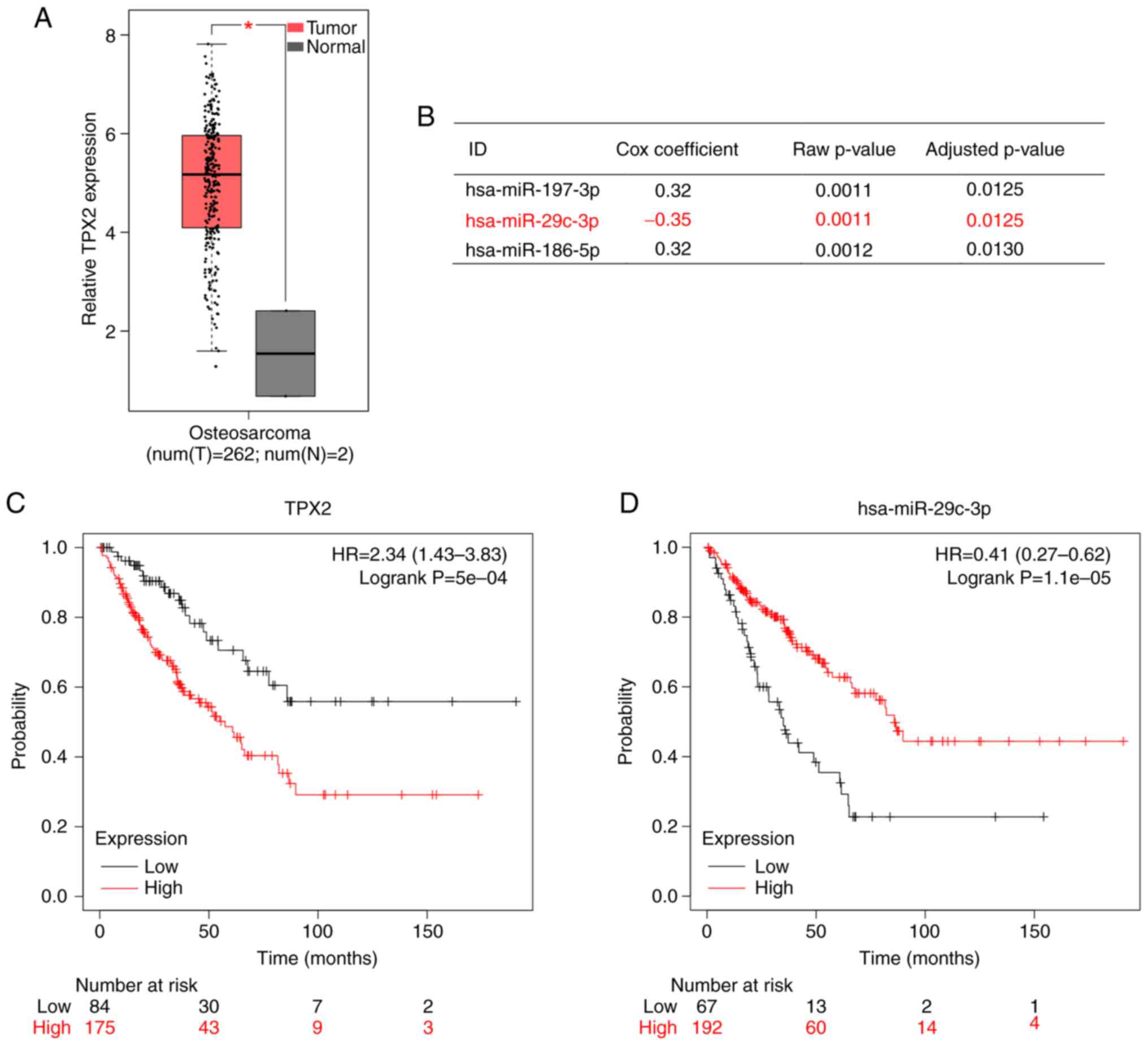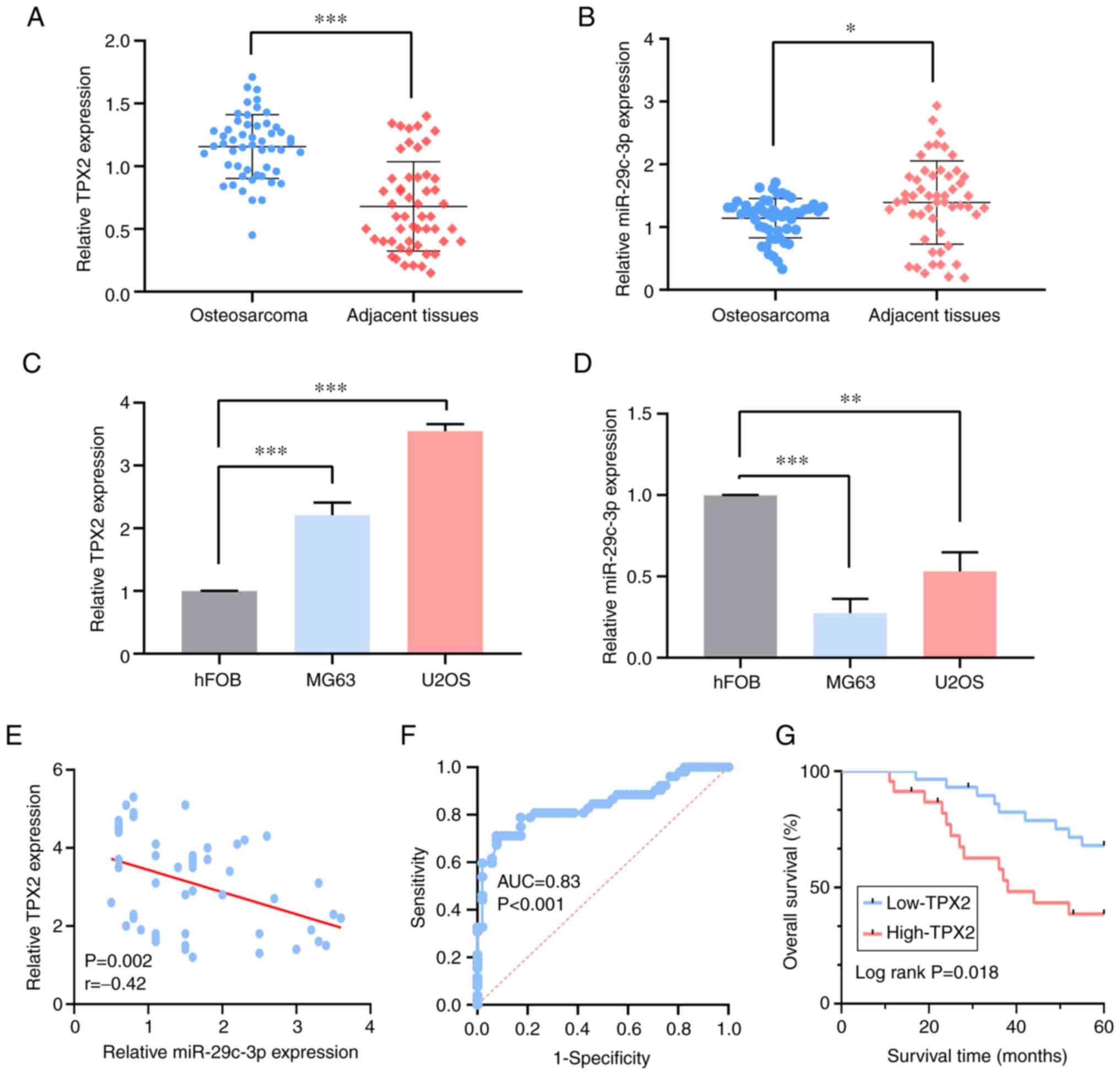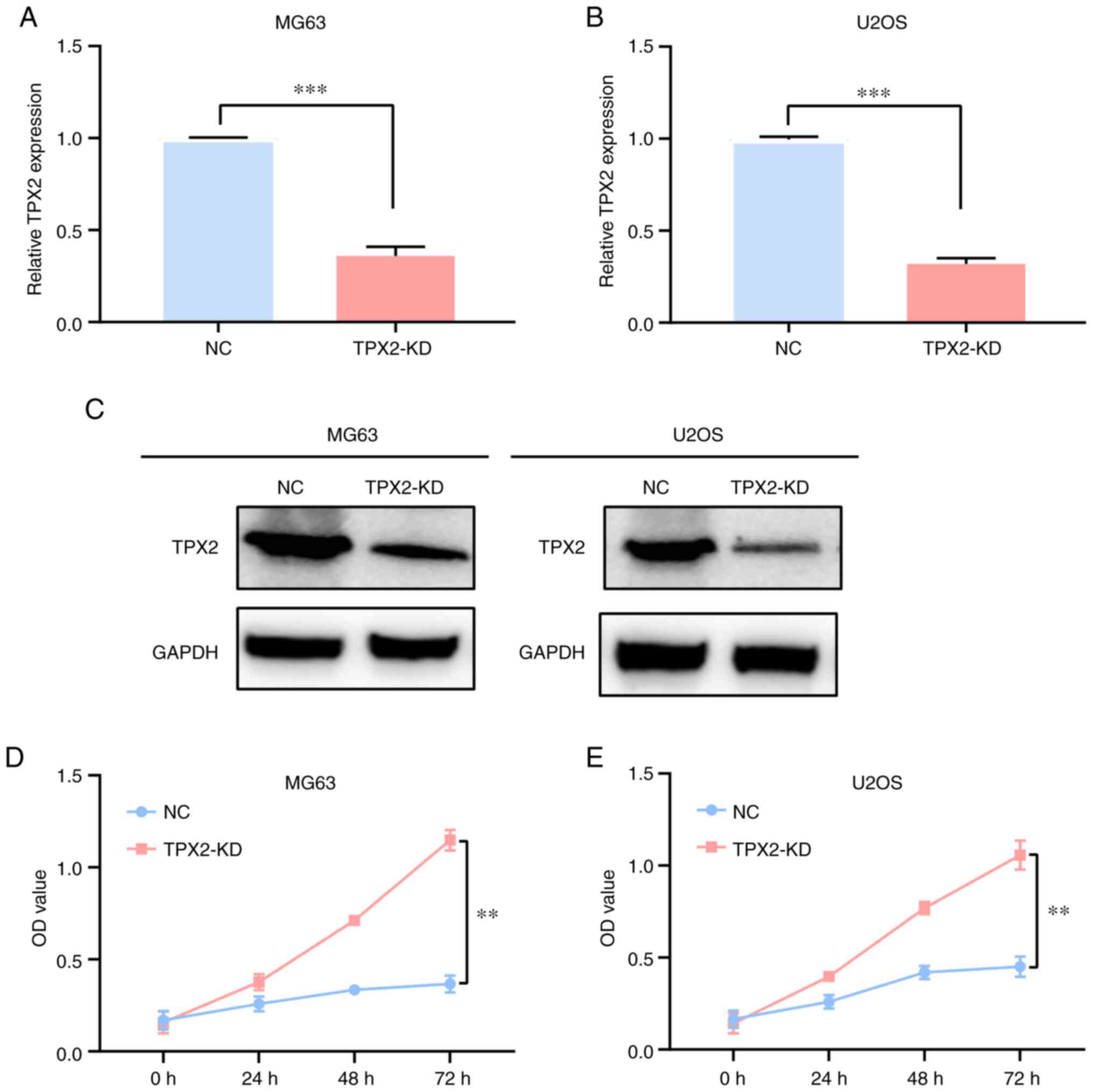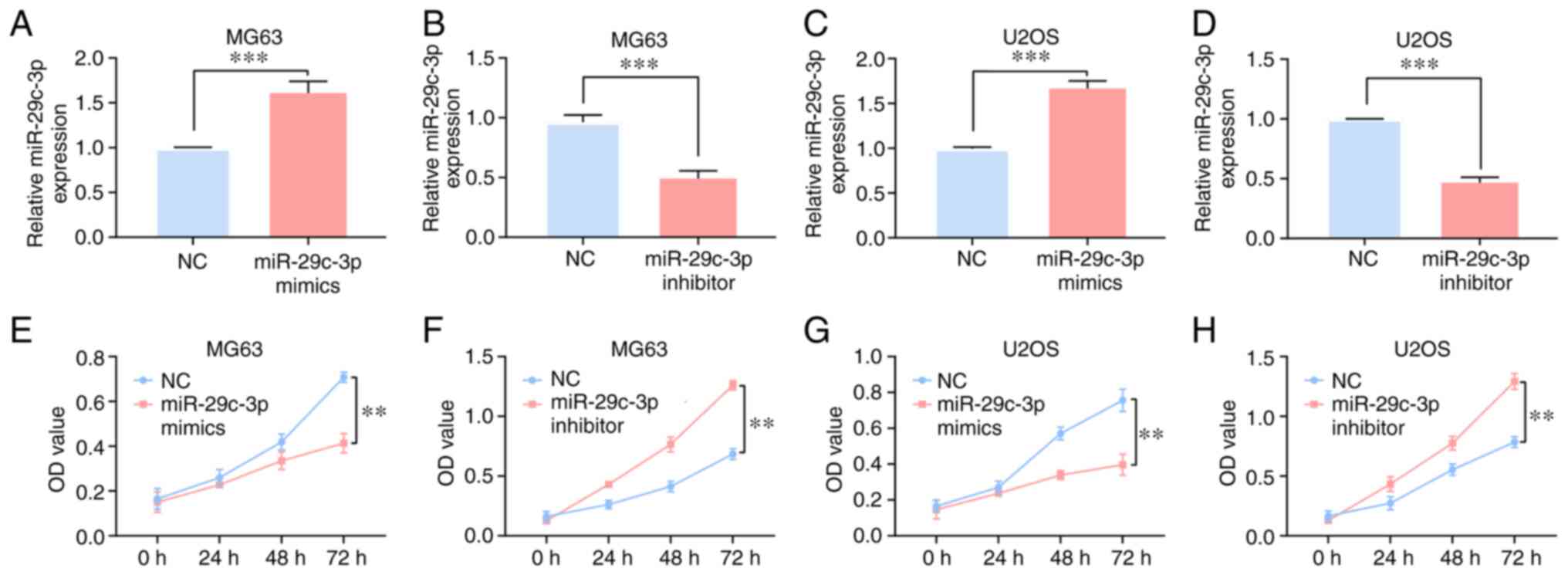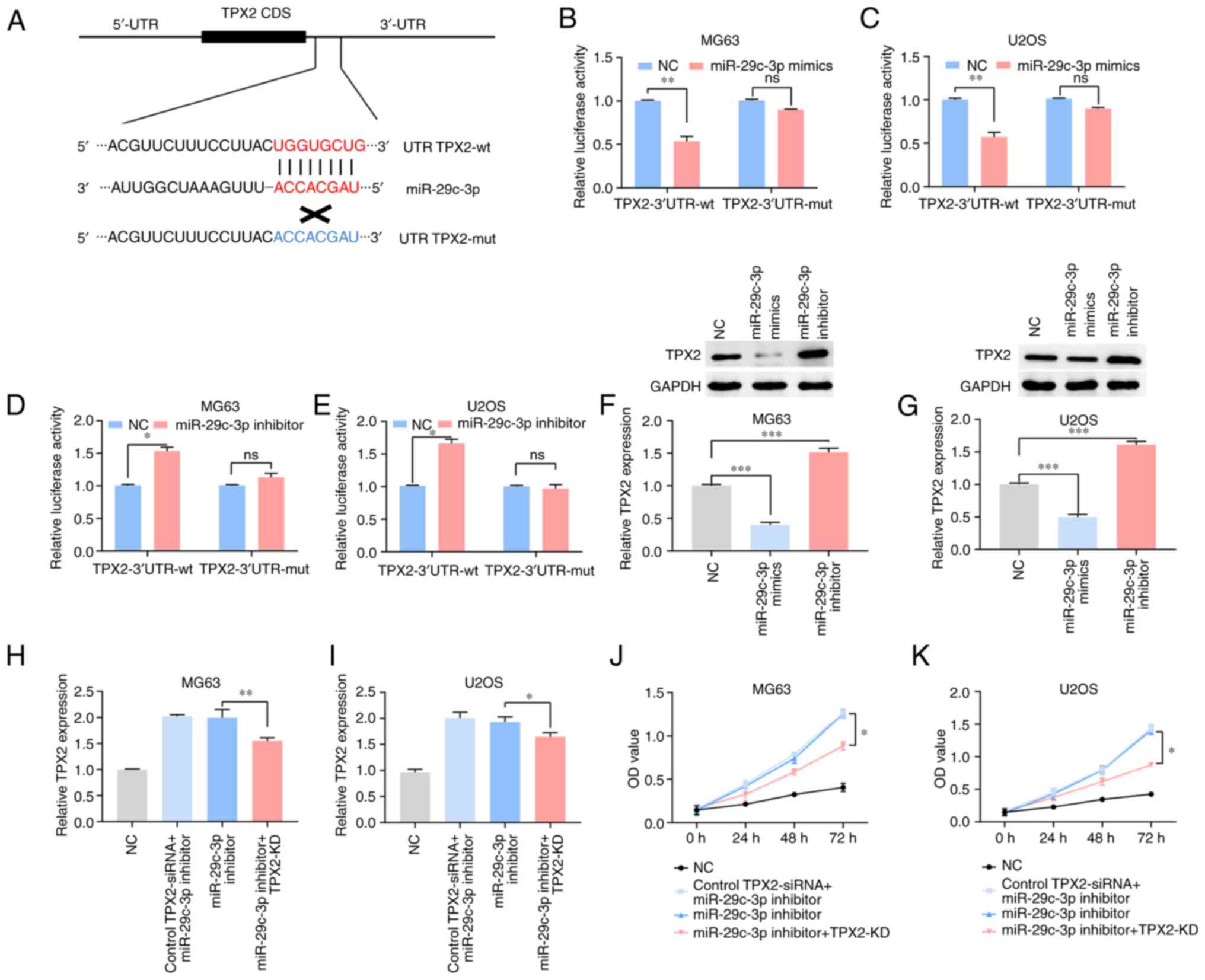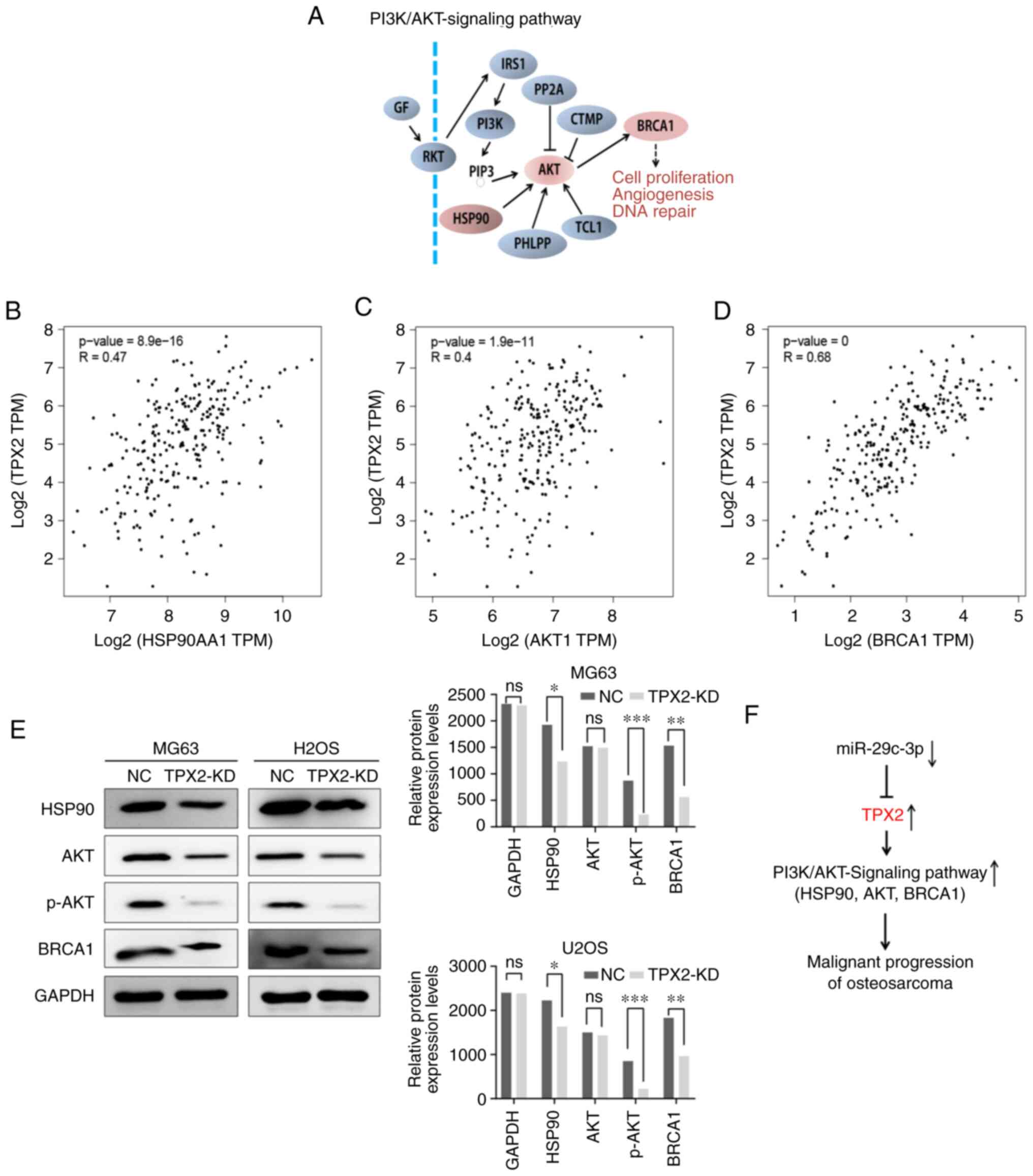TPX2 regulated by miR‑29c‑3p induces cell proliferation in osteosarcoma via the AKT signaling pathway
- Authors:
- Published online on: March 11, 2022 https://doi.org/10.3892/ol.2022.13262
- Article Number: 143
-
Copyright: © Zhu et al. This is an open access article distributed under the terms of Creative Commons Attribution License.
Abstract
Introduction
Osteosarcoma, a common primary bone tumor in adolescents and young adults, is one of the leading causes of tumor-related mortality in individuals <18 years old (1). Over the past few years, owing to the combination of surgery with chemotherapy, the 5-year survival rate for patients with osteosarcoma has remained at between 50 and 80% (2). However, the prognosis of osteosarcoma patients is still poor, and distant metastasis or local recurrence after primary tumor resection remains a major clinical problem (3). Osteosarcoma tumorigenesis and malignant progression have previously been found to be associated with genetic mechanisms, but the complicated molecular mechanism of the disease has not been revealed (4–7). Therefore, the molecular mechanism of osteosarcoma requires investigation and it is important that effective therapeutic targets are determined.
Aneuploidy is considered to be a major feature of chromosomal instability and cancer development (8). Targeting protein for Xenopus kinesin-like protein 2 (TPX2) is a microtubule-associated protein critical for spindle morphogenesis that plays a key role in chromosomal instability (9). Upregulation of TPX2 can cause centrosome amplification and lead to DNA polyploidy, thus regulating cell proliferation, apoptotic processes and cell division (10). Upregulation of TPX2 has been reported in multiple types of cancer, including colon, lung, pancreatic, cervical and salivary gland cancer (11–15). These observations indicate that TPX2 plays a pivotal role in the oncogenesis of malignancies. However, it is unclear whether TPX2 is involved in the occurrence and development in osteosarcoma.
Therefore, the aim of the present study was to evaluate the effect of TPX2 on the development of osteosarcoma. The study proposed to systematically summarize the expression of TPX2 and clarify the molecular mechanisms of TPX2 in the promotion of osteosarcoma proliferation.
Materials and methods
Bioinformatics analysis
TPX2 and microRNA (miRNA/miR)-29c-3p expression levels were explored using the Gene Expression Profiling Interactive Analysis (GEPIA) (http://gepia.cancer-pku.cn/index.html) and OncoLnc (http://www.oncolnc.org/) databases, respectively. In GEPIA, the term ‘TPX2’ was used in the ‘Gene’ field and ‘SARC’ was used in the ‘Datasets Selection’ field. Differential expression of TPX2 was defined with the following significance cutoff levels: |Log2FC|>1 and P<0.01. In OncoLnc, ‘SARC’ was selected in the ‘miRNA’ column, and the data was downloaded. The information for miR-29c-3p was obtained. The Kaplan Meier plotter (http://kmplot.com/analysis/) was used to analyze the overall survival of patients with different levels of TPX2 and miR-29c-3p expression in sarcoma. TargetScan (http://www.targetscan.org/vert_71/) was used to explore the potential association between TPX2 and miR-29c-3p.
Patients and specimens
Between January 2008 and December 2018 (age range, 2–54 years; average age, 19.47±3.30 years), a total of 52 pairs of primary osteosarcoma and adjacent noncancerous tissues were obtained from patients who had undergone a wide resection of osteosarcoma at the First People's Hospital of Lianyungang (Lianyungang, China). Inclusion criteria were as follows: Osteosarcoma patients without radiotherapy or chemotherapy before surgery. Exclusion criteria were as follows: i) Osteosarcoma patients who received radiotherapy or chemotherapy before surgery; and ii) patients who refused to sign the informed consent form. Morphologically normal tissues that were <5 cm from the cancerous tissues were used as adjacent noncancerous tissues. All samples were frozen at −80°C until further use. The histological diagnosis of osteosarcoma conformed to the World Health Organization's histological criteria for osteosarcoma (16), as confirmed by two professional pathologists.
Ethical statement
The Ethics Committee of the First People's Hospital of Lianyungang approved all protocols, which complied with the Declaration of Helsinki (December 2018; approval no. 20180203). Written informed consent was obtained from all patients and/or their legal guardians.
Cell culture
Human osteosarcoma MG63 and U2OS cell lines, and the human normal osteoblastic hFOB cell line were purchased from The Cell Bank of Type Culture Collection of the Chinese Academy of Sciences. All cells were cultured in DMEM (Invitrogen; Thermo Fisher Scientific, Inc.) supplemented with 10% fetal bovine serum (Gibco; Thermo Fisher Scientific, Inc.), 100 U/ml penicillin and 100 µg/ml streptomycin at 37°C in a humidified incubator containing 5% CO2.
RNA isolation and reverse transcription-quantitative PCR (RT-qPCR)
RNA isolation and RT-qPCR were performed as described previously (17). TRIzol® reagent (Invitrogen; Thermo Fisher Scientific, Inc.) was used to extract RNA from the three cell lines and the tissues. Next, the EasyScript One Step gDNA Removal and cDNA Synthesis SuperMix (Beijing TransGen Biotech Co., Ltd.) was used to acquire the first strand cDNA according to the manufacturer's instructions. Next, qPCR was performed using SYBR-Green Master Mix kit (Roche Diagnostics GmbH) with an Applied Biosystems 7900 Real-Time PCR System (Thermo Fisher Scientific, Inc.). The reaction conditions were as follows: Pre-denaturation at 95°C for 15 min, followed by 35 cycles of denaturation at 95°C for 15 sec, annealing at 58°C for 30 sec and extension at 72°C for 5 min, and then a final extension at 72°C for 15 min. Expression levels of RNA were calculated based on the comparative 2−ΔΔCq method (18). U6 was used as an endogenous control for miR-29c-3p, and β-actin was used as an endogenous control for TPX2. All experiments were performed in triplicate. The primers used are listed in Table I.
siRNA transfection
Knockdown experiments for TPX2 were performed using siRNA oligonucleotides purchased from Shanghai GenePharma Co., Ltd. The TPX2 siRNA sequences were as follows: Forward, 5′-CCAUUAACCUGCCAGAGAAT-3′ and reverse, 5′-UUCUCUGGCAGGUUAAUGGT-3′. The negative control for siRNA silencing was a non-targeting (scramble) siRNA sequence, with the sequence 5′-UUCUCCGAACGUGUCACGUTT-3′. MG63 and U2OS cells were plated in 6-well plates at a density of 2×105 cells/well and cultured in growth medium until cell confluence reached 70%. Transfection of siRNA (20 nM) was then performed using Lipofectamine® 3000 (Invitrogen; Thermo Fisher Scientific, Inc.) according to the manufacturer's instructions. Transfection was performed at 37°C for 6 h before replacing the transfection medium with full culture medium. At 48 h post-transfection, cells were harvested for RT-qPCR or western blot analysis.
Cell proliferation assay
The MG63 and U2OS cells were seeded in 96-well plates at a density of 1,000 cells per well with 5 replicate wells at 48 h post-siRNA transfection. Cell proliferation was measured using an MTT assay at 0, 24, 48 and 72 h after seeding. Next, 150 µl dimethylsulfoxide was added per well to dissolve the purple formazan. The absorbance was measured at a wavelength of 490 nm using a microplate reader. All proliferation experiments were performed in triplicate.
Luciferase reporter assay
MG63 and U2OS cells were seeded into 24-well plates. After 24 h of incubation, 6 ng pmirGLO report vector (Shanghai GenePharma Co., Ltd.) carrying the wild-type (wt) or mutant (mut) 3′-untranslated region (3′-UTR) of TPX2 was cotransfected with miR-29c-3p mimics (100 nmol/l) or miR-29c-3p inhibitors (100 nmol/l) into the osteosarcoma cells using a Lipofectamine 2000 kit (Invitrogen; Thermo Fisher Scientific, Inc.). The negative controls for the miRNA mimics and inhibitors were non-targeting sequences. The sequences of the mimics, inhibitors and negative controls were as follows: miR-29c-3p mimic sense, 5′-UAGCACCAUUUGAAAUCGGUUA-3′ and antisense, 5′-UAACCGAUUUCAAAUGGUGCUA-3′; negative control mimic sense, 5′-UCACAACCUCCUAGAAAGAGUAGA-3′ and anti-sense, 5′-UCUACUCUUUCUAGGAGGUUGUGA-3′; miR-29c-3p inhibitor, 5′-UCUACUCUUUCUAGGAGGUUGUGA-3′; and negative control inhibitor, 5′-UAACCGAUUUCAAAUGGUGCUA-3′ (Shanghai GenePharma Co., Ltd.). The amplified TPX2 wt or mut 3′UTR containing the miR-29c-3p target sites was inserted into the pMIR-GLO luciferase reporter vectors (Shanghai GenePharma Co., Ltd.). At 48 h post-transfection, luciferase activities were examined with a dual-luciferase reporter system (Shanghai GenePharma Co., Ltd.) and normalized with Renilla luciferase activity using SpectraMax i3 (Molecular Devices LLC).
Western blot analysis
Western blotting analysis was performed as previously reported (17). MG63 and U20S cell lines were analyzed. Primary antibodies involved in this assay were as follows: Anti-TPX2 (1:1,000; catalog no. ab71816), anti-HSP90 (1:5,000; catalog no. ab203085), anti-AKT (1:500; catalog no. ab8805), anti-p-AKT (1:1,000; catalog no. ab18206), anti-BRCA1 (1:1,000; catalog no. ab245330) and anti-GAPDH (1:1,000; catalog no. ab9485) (all Abcam). The secondary antibody was anti-rabbit IgG (1:4,000; catalog no. ab150077; Abcam). Primary antibodies were incubated at 4°C overnight, and secondary antibody was incubated for 1 h at room temperature. The protein bands were detected by a chemiluminescence detection system (Beyotime Institute of Biotechnology). Pierce ECL Western Blotting Substrate (cat. no. 32109; Thermo Fisher Scientific, Inc.) was used to visualize the bound antibodies. Image analysis was performed using ImageJ software (version 1.42; National Institutes of Health).
Statistical analysis
Statistical analyses were performed using GraphPad Prism 8.0 (GraphPad Software, Inc.). Values are presented as the mean ± standard deviation. The significance of differences between two groups was assessed by paired or unpaired Student's t-test. Pearson's χ2 and Fisher's exact tests were performed to assess the categorical variables. Prognostic significance was determined by Kaplan-Meier and log-rank analyses. A receiver operating characteristic (ROC) curve was calculated to determine the area under the curve (AUC) for biomarkers. Pearson's correlation was used to evaluate the strength of linear correlation between two continuous variables. P<0.05 was considered to indicate a statistically significant difference.
Results
TPX2 expression is upregulated and miR-29c-3p expression is decreased in sarcoma
By analysis of the GEPIA public database, the relative expression of TPX2 was found to be significantly higher in sarcoma tissues (n=262) compared with that in normal tissues (n=2) at the mRNA level (Fig. 1A). The OncoLnc database showed that miR-29c-3p was expressed at lower levels in tumor tissues compared with that in normal tissues (Fig. 1B). Kaplan-Meier plotter indicated that patients with high TPX2 expression experienced poor overall survival (Fig. 1C), while those with high miR-29c-3p expression experienced favorable overall survival (Fig. 1D). In 52 pairs of osteosarcoma tissues and adjacent normal tissues, the expression of TPX2 was significantly upregulated in tumor tissues compared with that in paired adjacent normal tissues (Fig. 2A). Additionally, miR-29c-3p expression was downregulated in osteosarcoma (Fig. 2B). Furthermore, the TPX2 expression level was measured in MG63 and U2OS cell lines. The RT-qPCR analysis showed significantly higher mRNA levels of TPX2 in these tumor cells compared with that in normal hFOB cells (Fig. 2C). By contrast, miR-29c-3p expression was downregulated in the osteosarcoma cell lines (Fig. 2D). Pearson's correlation analysis disclosed a significant negative correlation between TPX2 and miR-29c-3p expression in osteosarcoma (P=0.002, r=−0.42) (Fig. 2E).
Association between TPX2 expression and the clinicopathological characteristics of the osteosarcoma patients
The optimal cut-off value of TPX2 was determined by ROC analysis based on its expression level (P<0.001, AUC=0.83) (Fig. 2F). The 52 patients were consequently divided into two groups: TPX2 high expression (n=28) and TPX2 low expression (n=24). The associations between TPX2 expression and various clinicopathological characteristics are shown in Table II. The results indicated that high TPX2 expression level was significantly associated with tumor size (P=0.019), clinical stage (P=0.002) and distant metastasis (P=0.018), compared with low expression level. However, no association was found with other clinical parameters, such as age, sex and anatomical location. Kaplan-Meier and log-rank test analysis revealed that high TPX2 expression was significantly associated with a poor prognosis (P=0.018) (Fig. 2G).
Knockdown of TPX2 inhibits osteosarcoma cell proliferation
TPX2 siRNA plasmids were transfected into MG63 and U2OS osteosarcoma cell lines to knockdown TPX2 expression. RT-qPCR was then used to explore the efficiency of the knockdown (Fig. 3A and B). The transfection efficiency was also confirmed by western blotting (Fig. 3C). MTT assays results indicated that TPX2 knockdown inhibited osteosarcoma MG63 and U2OS cell line proliferation (Fig. 3D and E).
miR-29c-3p inhibits osteosarcoma cell proliferation
In osteosarcoma MG63 and U2OS cell lines, after transfection of miR-29c-3p mimics or inhibitors, the efficiency was confirmed by RT-qPCR (Fig. 4A-D). MTT assays results indicated that miR-29c-3p mimics could significantly decrease the proliferation of the MG63 and U2OS cell lines, while miR-29c-3p inhibitors could significantly promote MG63 and U2OS cell line proliferation (Fig. 4E-H).
miR-29c-3p targets TPX2 and decreases TPX2 expression in osteosarcoma cell lines
Using the TargetScan database, it was determined that the TPX2 3′UTR included a putative miR-29c-3p binding site (Fig. 5A). This notion was subsequently validated using a luciferase reporter assay. MG63 and U2OS cell lines were cotransfected with luciferase reporter vectors containing TPX2-3′UTR-wt or TPX2-3′UTR-mut, along with miR-29c-3p mimics or inhibitors. Luciferase reporter gene assay revealed that miR-29c-3p mimics significantly inhibited luciferase activity in the TPX2-wt group (Fig. 5B and C) and that miR-29c-3p inhibitors promoted luciferase activity in the TPX2-wt group (Fig. 5D and E). Additionally, TPX2 expression decreased in miR-29a-5p mimics, while it increased in the miR-29c-3p inhibitors group compared with the NC (Fig. 5F and G). Taken together, these data show that TPX2 is a target gene of miR-29c-3p and that a negative correlation exists between miR-29c-3p and TPX2 in osteosarcoma.
Knockdown of TPX2 markedly reverses miR-29c-3p-mediated inhibition of cell proliferation in osteosarcoma cell lines
The findings showed that, compared with that in the NC group, TPX2 expression in MG63 and U2OS cells transfected with miR-29c-3p inhibitors increased; however, when cotransfected with TPX2 siRNA and miR-29c-3p inhibitors, the expression of TPX2 was significantly decreased compared with that in the group without siRNA (Fig. 5H and I). MTT assays results indicated that the knockdown of TPX2 significantly reversed miR-29c-3p inhibitor-mediated promotion of cell proliferation in the osteosarcoma cell lines (Fig. 5J and K).
Silencing of TPX2 suppresses AKT signaling pathway activity in osteosarcoma cells
The AKT signaling pathway is an important signaling pathway that controls the proliferation of cancer cells (Fig. 6A). A positive correlation was found between TPX2 and the three key genes in the AKT signaling pathway using the GEPIA database (Fig. 6B-D). Western blotting was used to detect the protein expression levels of HSP90, AKT and BRCA1 in osteosarcoma cells after TPX2 silencing, in order to determine the effect of TPX2 on the AKT pathway. It was found that the expression of the aforementioned key genes was decreased when TPX2 was knocked down in U2OS and MG63 cells (Fig. 6E). Taken together, the results showed that TPX2 regulated by miR-29c-3p induces cell proliferation in osteosarcoma via the AKT signaling pathway (Fig. 6F).
Discussion
As the most frequently occurring malignant bone tumor in adolescents and young adults, osteosarcoma accounts for ~20% of pediatric, malignant and solid tumors. Although improvements have been made with regard to the diagnosis and treatment of osteosarcoma, the overall survival rate has been fairly constant for >20 years (19). Accumulating evidence has demonstrated that osteosarcoma is a complex disease that involves multiple genes (20). Therefore, determining the underlying molecular mechanism for osteosarcoma will aid the search for novel diagnostic biomarkers and therapeutic targets for this disease.
Previously, numerous studies have analyzed the association between TPX2 and human malignancy (12–14). To the best of our knowledge, the present study is the first to focus on TPX2 function in osteosarcoma. The clinical study of patients with osteosarcoma demonstrated that TPX2 expression was upregulated in human osteosarcoma tissues. TPX2 expression levels in osteosarcoma were also closely associated with tumor size (P=0.019), clinical stage (P=0.002) and distant metastasis (P=0.018), and high TPX2 expression levels predicted a worse prognosis for affected patients. Similar to the present study, Cai et al (21) noted that TPX2 was a novel predictor of metastasis risk in breast cancer. A previous study on esophageal cancer also found that high expression of TPX2 was an independent prognostic factor, and that knocking down TPX2 expression could significantly inhibit the proliferation of esophageal cancer cells (22). In the present study, the analysis based on the ROC curve showed that the AUC was 0.83, meaning that TPX2 may be a highly sensitive predictor for the diagnosis of osteosarcoma. Furthermore, Kaplan-Meier analyses indicated that patients with high TPX2 expression experienced a markedly shorter overall survival time compared with patients with low TPX2 expression (P=0.018). Overall, TPX2 could be used as an effective biomarker of prognosis in patients with osteosarcoma and may be a potential therapeutic target of the disease.
miRNA serves an important role in the regulation of numerous cellular processes, including proliferation, differentiation and apoptosis. Mature miRNA binds to the complementary sequence at the 3′UTR of its target mRNA, thus inhibiting mRNA translation or inducing its degradation, and exerting a negative regulatory effect on gene expression. In the present study, using TargetScan, miR-29c-3p was assessed and found to have a targeted binding site with TPX2. This miRNA was downregulated in the patients with osteosarcoma. miR-29 has been reported to restrain proliferation, migration and invasion in breast cancer cells through the targeting of PDCD4 (23). In osteosarcoma, Liu et al (24) demonstrated that miR-29 could target PTEN to inhibit cell proliferation and migration. Ma et al (25) revealed that miR-29c-3p was able to inhibit the malignant progression of osteosarcoma by targeting PIK3R3. In 2018, one study of human osteosarcoma revealed that hsa-circ-001564 was upregulated in tumor tissues and that it aggravated the malignant process by the negative targeting of miR-29c-3p in MG63 and HOS cell lines, as measured by colony formation and cell apoptosis assays (26). Recently, it was found that miR-29c-3p could modulate FOS expression to inhibit epithelial-mesenchymal transition and cell proliferation, while inducing apoptosis in TGF-β2-treated lens epithelial cells regulated by lncRNA KCNQ1OT1 (27). The present study also verified that miR-29c-3p could regulate the expression of TPX2 at the cellular level, and that overexpression of miR-29c-3p could reverse the TPX2 inhibitory impact on the proliferation of osteosarcoma cell lines.
The AKT signaling pathway is known to play an important role in malignant tumor occurrence and development, and AKT activation is associated with the proliferation of tumor cells (28,29). Two different studies previously reported that inhibiting TPX2 could result in tumor suppression by inhibiting the AKT signaling pathway in hepatocellular carcinoma (30,31). Similar findings were observed in breast cancer (32). In the present study, the knockdown of TPX2 was found to suppress the proliferation of osteosarcoma cells. HSP90 serves a vital role in the stability of a number of proteins that are crucial for cell survival, and contributes to the functional stabilization of PI3K/Akt signaling and cell survival (33). The activation of AKT also seems to support BRCA1 nuclear localization, and co-expression of BRCA1 and activated AKT decreases radiation sensitivity, indicating the functional consequences of this interaction with regard to the role of BRCA1 in DNA repair (34). Additionally, TPX2 knockdown resulted in altered protein expression levels of HSP90, AKT and BRCA1, indicating that TPX2 may promote the activation of AKT signal transduction.
A number of studies have reported that the activation of TPX2 is associated with a variety of different cancer types (12–15), but the molecular mechanisms underlying TPX2 function in osteosarcoma are not well understood.
Overall, TPX2 may be used as a biomarker for the diagnosis and prognosis of osteosarcoma, and is expected in future to provide novel targets for the treatment of this disease. However, there were some limitations to the present study. Firstly, the clinical sample size used was relatively small. In addition, the study was only conducted in vitro. The association between miR-29c-3p expression and the clinicopathological characteristics of patients with osteosarcoma needs further investigation. Lastly, the study only analyzed the effects of TPX2 and miR-29c-3p on osteosarcoma cancer cells in terms of cell proliferation. Therefore, the other potential molecular mechanism, i.e., that TPX2 enhances the carcinogenesis of osteosarcoma, requires further investigation. Future studies will use the miR-29c-3p/TPX2/AKT axis as a target site for osteosarcoma molecular therapy, in order to improve the therapeutic effects and prognosis of patients with osteosarcoma.
In conclusion, the results of the present study indicated that TPX2 could exert an effect on tumor progression by activating the AKT signaling pathway in osteosarcoma, and that this effect may be suppressed by miR-29c-3p. TPX2 could be used as a potential target and biomarker for future novel therapeutic development.
Acknowledgements
Not applicable.
Funding
Funding: No funding was received.
Availability of data and materials
The datasets used and/or analyzed during the current study are available from the corresponding author on reasonable request.
Authors' contributions
DZ wrote the manuscript. DZ and XX performed the experiments. DZ, XX, MZ and TW collected the patients' samples. DZ, XX, MZ and TW designed the experiments and analyzed the data. DZ, XX, MZ and TW critically revised the manuscript for important intellectual content. DZ helped with the statistical analysis. DZ, XX, MZ and TW confirm the authenticity of all the raw data. All authors have read and approved the final manuscript.
Ethics approval and consent to participate
The present study was approved by the Ethics Committee of the First People's Hospital of Lianyungang (Lianyungang, China). Written informed consent was obtained from all patients and/or their legal guardians.
Patient consent for publication
Not applicable.
Competing interests
The authors declare that they have no competing interests.
References
|
Eaton BR, Schwarz R, Vatner R, Yeh B, Claude L, Indelicato DJ and Laack N: Osteosarcoma. Pediatr Blood Cancer. 68 (Suppl 2):e283522021. View Article : Google Scholar : PubMed/NCBI | |
|
Sadykova LR, Ntekim AI, Muyangwa-Semenova M, Rutland CS, Jeyapalan JN, Blatt N and Rizvanov AA: Epidemiology and risk factors of osteosarcoma. Cancer Invest. 38:259–269. 2020. View Article : Google Scholar : PubMed/NCBI | |
|
Bishop MW, Janeway KA and Gorlick R: Future directions in the treatment of osteosarcoma. Curr Opin Pediatr. 28:26–33. 2016. View Article : Google Scholar : PubMed/NCBI | |
|
Marina N, Gebhardt M, Teot L and Gorlick R: Biology and therapeutic advances for pediatric osteosarcoma. Oncologist. 9:422–441. 2004. View Article : Google Scholar : PubMed/NCBI | |
|
Knott MM, Hölting TL, Ohmura S, Kirchner T, Cidre-Aranaz F and Grünewald TG: Targeting the undruggable: Exploiting neomorphic features of fusion oncoproteins in childhood sarcomas for innovative therapies. Cancer Metastasis Rev. 38:625–642. 2019. View Article : Google Scholar : PubMed/NCBI | |
|
Glover J, Man TK, Barkauskas DA, Hall D, Tello T, Sullivan MB, Gorlick R, Janeway K, Grier H, Lau C, et al: Osteosarcoma enters a post genomic era with in silico opportunities: Generation of the High Dimensional Database for facilitating sarcoma biology research: A report from the Children's Oncology Group and the QuadW Foundation. PLoS One. 12:e01812042017. View Article : Google Scholar : PubMed/NCBI | |
|
Perry JA, Kiezun A, Tonzi P, Van Allen EM, Carter SL, Baca SC, Cowley GS, Bhatt AS, Rheinbay E, Pedamallu CS, et al: Complementary genomic approaches highlight the PI3K/mTOR pathway as a common vulnerability in osteosarcoma. Proc Natl Acad Sci USA. 111:E5564–E5573. 2014. View Article : Google Scholar : PubMed/NCBI | |
|
Lengauer C, Kinzler KW and Vogelstein B: Genetic instabilities in human cancers. Nature. 396:643–649. 1998. View Article : Google Scholar : PubMed/NCBI | |
|
Carter SL, Eklund AC, Kohane IS, Harris LN and Szallasi Z: A signature of chromosomal instability inferred from gene expression profiles predicts clinical outcome in multiple human cancers. Nat Genet. 38:1043–1048. 2006. View Article : Google Scholar : PubMed/NCBI | |
|
Wieczorek M, Bechstedt S, Chaaban S and Brouhard GJ: Microtubule-associated proteins control the kinetics of microtubule nucleation. Nat Cell Biol. 17:907–916. 2015. View Article : Google Scholar : PubMed/NCBI | |
|
Taherdangkoo K, Kazemi Nezhad SR, Hajjari MR and Tahmasebi Birgani M: miR-485-3p suppresses colorectal cancer via targeting TPX2. Bratisl Lek Listy. 121:302–307. 2020.PubMed/NCBI | |
|
Huo C, Zhang MY, Li R, Zhou XJ, Liu TT, Li JP, Liu X and Qu YQ: Comprehensive analysis of TPX2-related ceRNA network as prognostic biomarkers in lung adenocarcinoma. Int J Med Sci. 17:2427–2439. 2020. View Article : Google Scholar : PubMed/NCBI | |
|
Gomes-Filho SM, Dos Santos EO, Bertoldi ER, Scalabrini LC, Heidrich V, Dazzani B, Levantini E, Reis EM and Bassères DS: Aurora A kinase and its activator TPX2 are potential therapeutic targets in KRAS-induced pancreatic cancer. Cell Oncol (Dordr). 43:445–460. 2020. View Article : Google Scholar : PubMed/NCBI | |
|
Jiang P, Shen K, Wang X, Song H, Yue Y and Liu T: TPX2 regulates tumor growth in human cervical carcinoma cells. Mol Med Rep. 9:2347–2351. 2014. View Article : Google Scholar : PubMed/NCBI | |
|
Shigeishi H, Ohta K, Hiraoka M, Fujimoto S, Minami M, Higashikawa K and Kamata N: Expression of TPX2 in salivary gland carcinomas. Oncol Rep. 21:341–344. 2009.PubMed/NCBI | |
|
Cates JMM: Simple staging system for osteosarcoma performs equivalently to the AJCC and MSTS systems. J Orthop. 36:2802–2808. 2018.PubMed/NCBI | |
|
Mu J, Fan L, Liu D and Zhu D: Overexpression of shugoshin1 predicts a poor prognosis for prostate cancer and promotes metastasis by affecting epithelial-mesenchymal transition. Onco Targets Ther. 12:1111–1118. 2019. View Article : Google Scholar : PubMed/NCBI | |
|
Livak KJ and Schmittgen TD: Analysis of relative gene expression data using real-time quantitative PCR and the 2(−Delta Delta C(T)) method. Methods. 25:402–408. 2001. View Article : Google Scholar : PubMed/NCBI | |
|
Joko R, Yamada D, Nakamura M, Yoshida A, Takihira S, Takao T, Lu M, Sato K, Ito T, Kunisada T, et al: PRRX1 promotes malignant properties in human osteosarcoma. Transl Oncol. 14:1009602021. View Article : Google Scholar : PubMed/NCBI | |
|
Tian W, Li Y, Zhang J, Li J and Gao J: Combined analysis of DNA methylation and gene expression profiles of osteosarcoma identified several prognosis signatures. Gene. 650:7–14. 2018. View Article : Google Scholar : PubMed/NCBI | |
|
Cai Y, Mei J, Xiao Z, Xu B, Jiang X, Zhang Y and Zhu Y: Identification of five hub genes as monitoring biomarkers for breast cancer metastasis in silico. Hereditas. 156:202019. View Article : Google Scholar : PubMed/NCBI | |
|
Hsu PK, Chen HY, Yeh YC, Yen CC, Wu YC, Hsu CP, Hsu WH and Chou TY: TPX2 expression is associated with cell proliferation and patient outcome in esophageal squamous cell carcinoma. J Gastroenterol. 49:1231–1240. 2014. View Article : Google Scholar : PubMed/NCBI | |
|
Gao G, Liang X and Ma W: Sinomenine restrains breast cancer cells proliferation, migration and invasion via modulation of miR-29/PDCD-4 axis. Artif Cells Nanomed Biotechnol. 47:3839–3846. 2019. View Article : Google Scholar : PubMed/NCBI | |
|
Liu Q, Geng P, Shi L, Wang Q and Wang P: miR-29 promotes osteosarcoma cell proliferation and migration by targeting PTEN. Oncol Lett. 17:883–890. 2019.PubMed/NCBI | |
|
Ma HZ, Wang J, Shi J, Zhang W and Zhou DS: MicroRNA-29c-3p inhibits osteosarcoma cell proliferation through targeting PIK3R3. Eur Rev Med Pharmacol Sci. 24:2239–2247. 2020.PubMed/NCBI | |
|
Song YZ and Li JF: Circular RNA hsa_circ_0001564 regulates osteosarcoma proliferation and apoptosis by acting miRNA sponge. Biochem Biophys Res Commun. 495:2369–2375. 2018. View Article : Google Scholar : PubMed/NCBI | |
|
Yao L, Yang L, Song H, Liu T and Yan H: MicroRNA miR-29c-3p modulates FOS expression to repress EMT and cell proliferation while induces apoptosis in TGF-β2-treated lens epithelial cells regulated by lncRNA KCNQ1OT1. Biomed Pharmacother. 129:1102902020. View Article : Google Scholar : PubMed/NCBI | |
|
Li H, Zhang Q, Wu Q, Cui Y, Zhu H, Fang M, Zhou X, Sun Z and Yu J: Interleukin-22 secreted by cancer-associated fibroblasts regulates the proliferation and metastasis of lung cancer cells via the PI3K-Akt-mTOR signaling pathway. Am J Transl Res. 11:4077–4088. 2019.PubMed/NCBI | |
|
Yun WK, Hu YM, Zhao CB, Yu DY and Tang JB: HCP5 promotes colon cancer development by activating AP1G1 via PI3K/AKT pathway. Eur Rev Med Pharmacol Sci. 23:2786–2793. 2019.PubMed/NCBI | |
|
Huang DH, Jian J, Li S, Zhang Y and Liu LZ: TPX2 silencing exerts anti-tumor effects on hepatocellular carcinoma by regulating the PI3K/AKT signaling pathway. Int J Mol Med. 44:2113–2122. 2019.PubMed/NCBI | |
|
Wang F, Zhao W, Gao Y, Zhou J, Li H, Zhang G, Guo D, Xie C, Li J, Yin Z and Zhang J: CDK5-mediated phosphorylation and stabilization of TPX2 promotes hepatocellular tumorigenesis. J Exp Clin Cancer Res. 38:2862019. View Article : Google Scholar : PubMed/NCBI | |
|
Chen M, Zhang H, Zhang G, Zhong A, Ma Q, Kai J, Tong Y, Xie S, Wang Y, Zheng H, et al: Targeting TPX2 suppresses proliferation and promotes apoptosis via repression of the PI3k/AKT/P21 signaling pathway and activation of p53 pathway in breast cancer. Biochem Biophys Res Commun. 507:74–82. 2018. View Article : Google Scholar : PubMed/NCBI | |
|
Redlak MJ and Miller TA: Targeting PI3K/Akt/HSP90 signaling sensitizes gastric cancer cells to deoxycholate-induced apoptosis. Dig Dis Sci. 56:323–329. 2011. View Article : Google Scholar : PubMed/NCBI | |
|
Nelson AC, Lyons TR, Young CD, Hansen KC, Anderson SM and Holt JT: AKT regulates BRCA1 stability in response to hormone signaling. Mol Cell Endocrinol. 319:129–142. 2010. View Article : Google Scholar : PubMed/NCBI |



